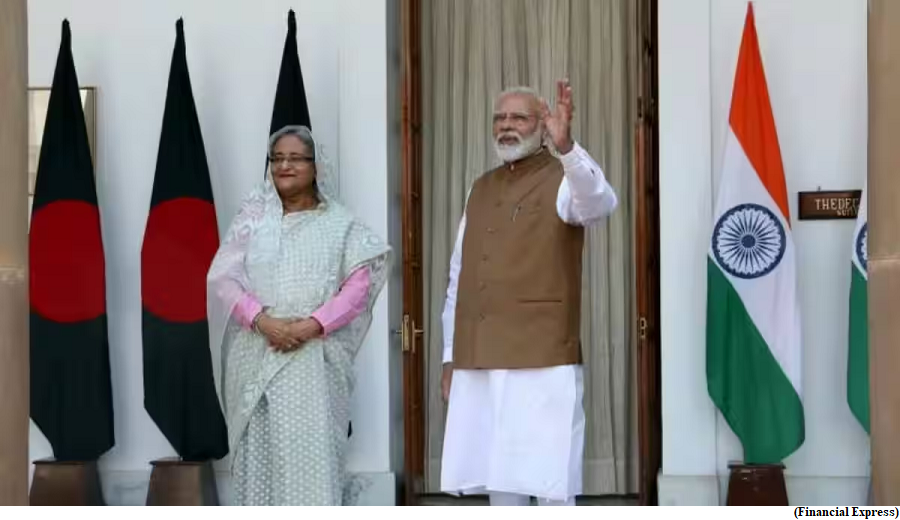Reviving Indo Bangladesh trade ties (GS Paper 2, International Relation)

Context:
- The current global economic context and the rapid pace of infrastructure development, particularly in eastern India and Bangladesh, presents a unique opportunity to revisit the Indo-Bangladesh economic relationship and jointly tackle the economic challenges post Covid-19.
Historical aspect:
- During the colonial period, Bengal and Assam were among the wealthier states in India, boasting a relatively higher per capita income.
Bengal’s growth:
- Bengal’s share in pre-partition India’s industrial production stood impressively high at 30%.
- Historically united as an economic, cultural, and ethnic group, the partition in 1947 caused an economic decline of Bengal that took years to recover from. Industries like jute, paper, and leather in West Bengal suffered, and the once-accessible sea route for exporting tea, timber, oil, and coal from Assam became unavailable, greatly impacting both states.
- The partition also fragmented the once-complementary resources on each side.
- Since then, India and Bangladesh have made significant strides. Bangladesh, once dubbed a “basket case” by a US diplomat, has transformed into an “inspiring story of growth,” as the World Bank now characterises it.
India’s growth:
- India has made remarkable progress in areas such as poverty reduction, basic literacy, women empowerment, healthcare, infrastructure development, digitalisation, financial inclusion, and more.
- It has transitioned from a primarily agrarian economy to a manufacturing powerhouse, with the ready-made garment industry driving impressive GDP growth over the past decade or so. Now, the country is on course to become a trillion dollar economy and a developed country by 2041.
- Similarly, India’s growth post-1991 was noteworthy, but it was primarily driven by the service sector. This growth narrative unfolded at the beginning of the 21st century, marked by significant strides in health, education, and poverty reduction.
Post Covid-19:
- However, the aftermath of Covid-19 has ushered in new challenges for both countries. Economic slowdown, diminished global demand, and disrupted supply chains have dealt severe blows to their economies.
- For instance, Bangladesh’s foreign reserves have dwindled due to sky-rocketing global energy and commodity price mainly caused by the Ukraine war and Covid-19. India too faced a bumpy post-Covid-19 trajectory.
- Nevertheless, considering the current global economic context and the rapid pace of infrastructure development, particularly in eastern India and Bangladesh, this presents a unique opportunity to revisit the Indo-Bangladesh economic relationship and jointly tackle the economic challenges post Covid-19. This shift entails leveraging each other’s strengths for outcomes that benefit both sides.
How both countries can strengthen each other?
- India’s north-eastern region, rich in resources like oil, natural gas, coal, and limestone contributes only about 2.8% to the GDP, due to inadequate connectivity and infrastructure. Bangladesh can play a pivotal role in repositioning this disparity.
- Recently, it has granted access to the Chattogram and Mongla seaports for transit and trans-shipment of Indian cargo vessels that will minimise connectivity problems of north-east India.
- Similarly, if granted, Bangladesh’s access to Nepal and Bhutan through India can foster sub-regional integration and development.
Matarbari port:
- The forthcoming Matarbari deep-sea port in southern Bangladesh, a Japan-backed project expected to be completed by 2027, could be a game-changer for the entire region including north-east and east India, Nepal, Bhutan, and so on.
- Improved infrastructure connectivity and access to port could accelerate growth in the region by creating a value chain.
- Furthermore, prospective value chain and multimodal connectivity centering the Matarbari port offers Bangladesh an opportunity to attract substantial foreign direct investment (FDI) from industries in eastern India and beyond. These industries have been looking for newer avenues to overcome their higher logistic costs.
- FDI has been one amongst the under-achieved areas of Bangladesh and its growth all these years have been mostly driven by exports and remittances. However, with significant interests of neighbours on the strategic Matarbari seaport, it can now look towards leveraging FDI to increase its foreign reserves.
Medical tourism:
- There exists significant potential for medical tourism between Bangladesh and India’s northeast.
- Assam’s government has made substantial investments in establishing top-tier healthcare infrastructure, collaborating with groups like Tata to provide high-quality cancer care facilities.
- This initiative could enable Assam not only to serve its own population but also to cater to neighbouring countries like Bangladesh with shared cultural ties.
- Better connectivity such as a Dhaka-Guwahati direct flight, bus services, and so on can catalyse this effort.
IT exports:
- Both Bangladesh and India have pursued distinct paths to sustained growth. India capitalised on IT exports, whereas Bangladesh became a manufacturing hub for garment exports.
- Bangladesh’s IT exports can learn from India’s success, and north-east India can learn from Bangladesh’s expertise in manufacturing.
Way Forward:
- The long-standing relationship between the two countries transcends typical bilateral ties and is often described as a bond of blood. India and Bangladesh have consistently stood by each other in times of adversity.
- The current global economic situation presents an opportunity for both countries to collaborate and emerge stronger in the years ahead.


